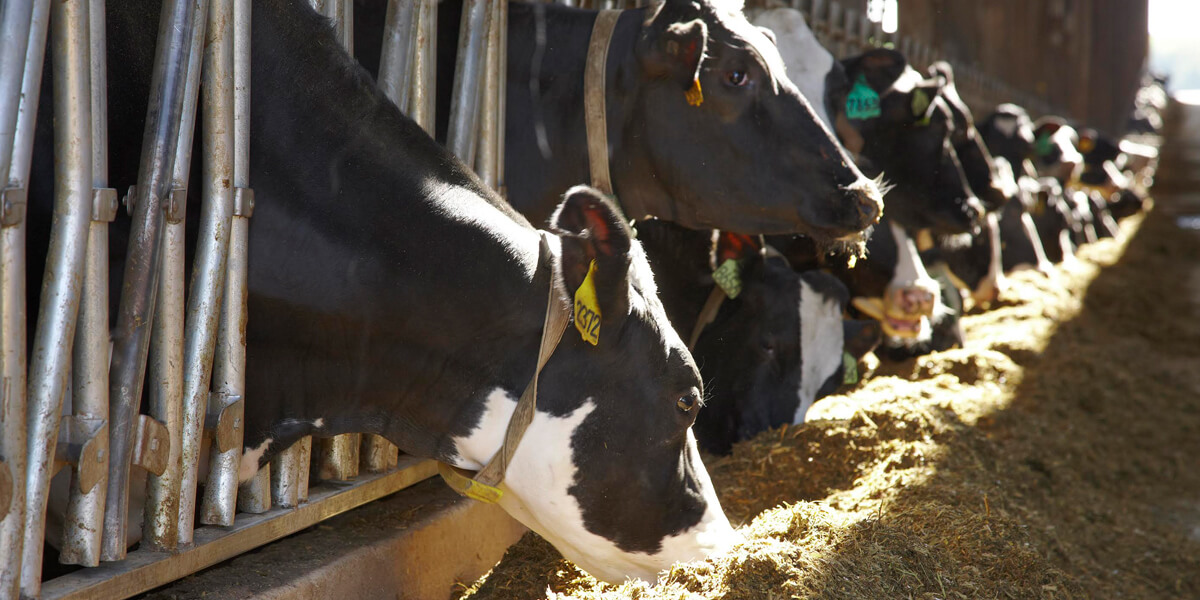The days are getting longer, and the summer heat will be here before you know it. As the days get warmer, we know that controlling the negative impacts caused by heat stress is a concern for dairy producers, but did you know that heat stress can also lead to other production issues that may not appear until the fall?
Every dairy cow has a threshold within which it will be able to perform its normal body functions and behave normally. When the environment is too hot and they start to experience heat stress (Temperature-Humidity Index above 68), the cow will start to modify its behavior to dissipate the extra heat.
For example, the first change cows may make is to spend less time resting during a heat stress event. For example, the first change cows may make is to spend less time resting during a heat stress event. Normally, when a cow lies down, its internal temperature will increase, so instead, the cow will spend more time standing in order to thermoregulate. This starts to threaten the 12 hours of rest per day cows need to recover from metabolic stress and achieve their target milk production.
Under heat stress conditions, blood flow is also diverted away from the gastrointestinal tract to the skin to help dissipate heat. This can weaken the tight junctions that hold the enterocytes together, leading to leaky gut and inflammation.
All of these factors will have immediate consequences for dairy cows, such as reduced feed intake, an increased inflammatory state demanding extra energy expenditure and a subsequent reduction in milk production. And over time, these changes can ultimately lead to dairy cow lameness in the fall, even after cooler temperatures have arrived.
Learn more: The Consequences of Heat Stress in Animals
Why Is Lameness Delayed After Heat Stress?
There are three main reasons that heat stress in the summer can eventually lead to lameness in the fall:
- As a cow spends more time standing instead of resting, it will accumulate more trauma on its feet, slowly affecting the process of keratin formation on the hoof and allowing lesions to appear.
- Heat abatement systems like sprinklers can have a negative impact on hoof integrity. This increased humidity can cause the hoof keratin to soften and lead to further damage. The water/slurry puddles can also be a source of increased infection in the hoof.
- As cows experience an increase in inflammatory responses due to heat stress, energy and nutrients will be diverted away from hoof keratin production to fuel their inflammatory response. This will cause a slow reduction in hoof production and quality, eventually leading to an increase in hoof lesions showing up in the fall.
Tips to Control Heat Stress and Reduce Lameness
The first step to preventing fall lameness caused by heat stress is to properly control heat stress during the summer with proven nutrition and heat abatement systems.
Proven Nutrition with Zinpro® Performance Minerals®
There are very few ways that we can actually increase a cow’s energy intake by increasing the density of the ration, because that creates a risk for additional digestive and metabolic problems. The main thing that dairy producers need to do is reserve the highest-quality, most digestible forages for cows that are at a higher risk of heat stress-related lameness, specifically transition and high-producing cows. Another important thing is to provide the cows with plenty of drinking water.
Additionally, dairy producers should add Zinpro Performance Minerals to the ration. Zinpro zinc, manganese and copper are critical tools for maintaining the immune system in dairy cows. They are also basic components in the creation of quality hoof keratin, epithelium maintenance, ligaments and tendons.
Feeding trace minerals with unrivaled absorption, Zinpro Performance Minerals, will help dairy cows absorb more nutrients and modulate the inflammatory response caused by heat stress – all while continuing to produce good quality hoof keratin and improve overall hoof integrity, helping prevent lameness.
Heat Abatement Strategies
When the temperature rises above 23 degrees Celsius (74 degree Fahrenheit) with average humidity of 50%, dairy producers will need to implement ventilation systems to improve air movement. These systems should be installed in the milking parlor, the closeup pen and the main barn, ventilating at a rate of 10 kilometers per hour (~500 feet per minute) and providing a volume of 1.6 cubic meters of air per hour (~1000 cubic feet per minute). Under the same humidity, when the temperature rises above 28 degrees Celsius (82 degrees Fahrenheit) dairy producers will also need to implement heat abatement with water sprinklers to cool the cows in cycles.
Learn more: Tips to Reduce Heat Stress in Dairy Cows
Mitigate Heat Stress, Prevent Lameness and Improve Production
Heat stress is one of the biggest factors contributing to dairy cow lameness. While heat stress can hinder milk production in the summer, the subsequent lameness could cause negative consequences to continue in the fall. Investing in strategies to control heat stress, such as ventilation, sprinklers, and Zinpro Performance Minerals, will drive a positive ROI.
The most successful managers I’ve worked with implemented day-to-day strategies while keeping an eye toward the future. Establishing the heat abatement strategies outlined above enables you to control the negative impacts of heat stress during the summer while also working to prevent dairy cow lameness from popping up in the fall.
For more tools to identify and prevent lameness in your herd, check out the resources on the Zinpro® FirstStep® page.

